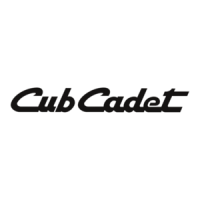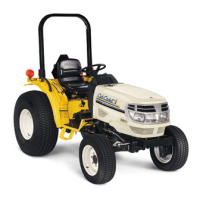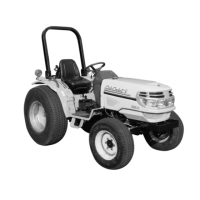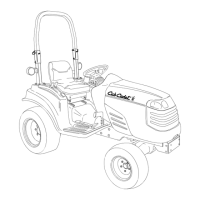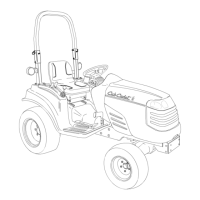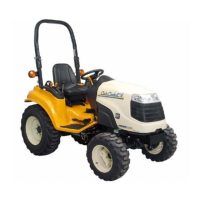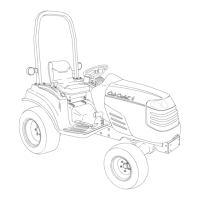

Do you have a question about the Cub Cadet 7254 and is the answer not in the manual?
| Engine Power | 25 HP |
|---|---|
| Horsepower | 25 hp |
| Transmission | Hydrostatic |
| Cutting Width | 54 inches |
| Turning Radius | 18 inches |
| Drive System | 4WD |
| Weight | 1110 lbs |
| Steering | Power |
| Brakes | Disc |
| Deck Material | Steel |
Explains the importance of the operator's manual for understanding tractor features, operation, and maintenance.
Highlights the role of the authorized dealer in providing service and genuine Cub Cadet parts for satisfactory operation.
States the engine manufacturer is responsible for all engine-related performance, power, and specification issues.
Advises contacting the dealer for tractor/equipment difficulties, operation/maintenance questions, or additional information.
Explains the importance of recording numbers from identification plates for dealer service or information.
Details the locations of the tractor model, engine information, transmission serial, and ROPS information plates.
Provides essential rules for safe tractor operation, including reading the manual, responsible operators, seat belts, and proper attire.
Details safety precautions for operating on slopes, emphasizing slow, gradual movements and avoiding sudden changes.
Stresses the importance of keeping children away from the operating area and supervising children operating the machine.
Outlines safety measures for operating PTO-driven equipment, including disengaging PTO before servicing.
Explains the function of the Rollover Protective Structure (ROPS) and seat belts in reducing injury during rollovers.
Covers safety practices for handling fuels, cooling systems, hydraulic fluid, and general maintenance.
Details the steps for starting and stopping the tractor as indicated on an instruction and warning label.
Describes various warning labels, including fan safety, starting aid warnings, and PTO safety.
Explains warnings related to battery handling, explosion hazards, and the safe use of ROPS and seat belts.
Identifies and describes controls mounted on the floorboard and dash panel, including steering wheel, PTO switch, and pedals.
Explains the function of the steering wheel, ignition switch positions, and proper use to prevent battery discharge.
Describes the operation of the PTO switch and the throttle handle for controlling engine speed.
Details the function of the brake pedal and the self-neutralizing forward/reverse pedal for tractor movement.
Explains how to adjust the operator's seat forward or backward for comfortable operation.
Describes the differential lock pedal for traction and the parking brake lever for securing the tractor.
Explains the choke control, hazard light switch, and headlight switch for engine starting and visibility.
Describes the function of various instrument panel components like fuel gauge, tachometer, and warning lights.
Introduces controls located on the tractor fenders, including fuel fill cap, PTO controls, and hydraulic lift.
Details the fuel fill cap safety and the PTO selection lever for engaging mid or rear PTO.
Explains the hydraulic lift lever for controlling implement height and the transmission Hi/Lo shift lever.
Covers the Hi/Lo range shift lever, storage tray, hazard lights, and tail/reverse lights for tractor operation.
Emphasizes the importance of using the ROPS and seat belt for operator safety during operation.
Details the function and importance of the Rollover Protective Structure and the safety interlock system.
Provides instructions and warnings for safely fueling the tractor with gasoline.
Outlines procedures for the first hours of operation to ensure optimal performance and longevity.
Provides step-by-step instructions and safety warnings for starting the tractor engine.
Offers guidance for starting the tractor in cold weather conditions.
Explains how to use jumper cables to start the engine and the correct procedure for stopping the tractor.
Provides guidelines for driving the tractor, including avoiding sudden movements and securing the tractor when unattended.
Details crucial safety measures and limitations for operating the tractor on inclines.
Explains the operation of the hydrostatic forward/reverse pedal for controlling tractor speed and direction.
Details how to use the Hi/Lo range shift lever to select speed ranges for optimal tractor performance.
Explains the function and safe operation of the differential lock pedal for enhanced traction.
Describes how to use the hydraulic lift lever to control the height of three-point hitch mounted equipment.
Details how to select and engage the rear, mid, or both PTO systems for operating attachments.
Explains the PTO reverse override switch and proper use of headlights, taillights, and hazard lights.
Covers the use of the hitch plate for towing and the three-point hitch system for mounting implements.
Explains how to add weights to the tractor for proper balance and stability when using implements.
Provides instructions for adjusting the operator's seat and seat belt for optimal comfort and safety.
Details how to adjust the three-point hitch links and chains for proper implement leveling.
Explains how to check and adjust the front wheel toe-in for proper steering alignment.
Describes how to check and adjust the tractor's brake linkage for proper braking performance.
Explains the importance of the hydraulic lift feedback rod adjustment for position control system function.
Provides a comprehensive table and guidelines for lubricating various tractor components.
Illustrates the locations of lubrication and maintenance points on the tractor.
Details the maintenance schedule, including intervals for checking, greasing, and changing various fluids and parts.
Provides instructions for opening the hood to access the engine and general safety information for handling batteries.
Explains battery removal, maintenance procedures, and proper storage to ensure battery longevity.
Provides instructions for replacing headlight, taillight, and hazard light bulbs.
Details how to replace instrument panel bulbs, access the fuse center, and check fuses and relays.
Explains how to replace the main fuse and the hazard light flasher relay.
Provides instructions for checking the oil level in the transmission and hydraulic system.
Details the procedure for changing the transmission and hydraulic system oil, including filter replacement.
Explains the procedure for changing the oil filters for the hydrostatic transmission and hydraulic system.
Provides instructions for checking the oil levels in the front axle and final reduction gear cases.
Details the procedure for changing the oil in the front axle and final reduction gear cases.
Explains lubrication of drive shafts and the procedure for retorquing wheel bolts.
Covers periodic inspection and maintenance of the Rollover Protective Structure (ROPS).
Provides guidelines for checking tire pressure, inflation safety, and tire maintenance.
Details how to use fuel stabilizer or empty the fuel system for long-term storage.
Covers general cleaning, coolant system prep, battery maintenance, and steps for removing the tractor from storage.
Explains the limited warranty for emission control systems on Kawasaki small off-road engines.
Outlines the owner's responsibilities to maintain warranty validity, including maintenance and timely issue reporting.
Details limitations on Kawasaki's liability and states that the warranty is exclusive and in lieu of other remedies.
Provides safety precautions for engine servicing and instructions for checking the engine oil level.
Details how to add engine oil and the procedure for changing the engine oil and oil filter.
Provides instructions and safety warnings for checking the engine coolant level in the overflow reservoir and radiator.
Explains how to inspect cooling system hoses and the procedure for changing the engine coolant.
Details the procedure for checking and changing the air cleaner components (precleaner, paper element).
Covers servicing the foam and paper air cleaner elements, and checking/replacing spark plugs.
Provides instructions for inspecting and replacing the tractor's in-line fuel filter.
Lists detailed specifications for the tractor's engine, including bore, stroke, displacement, and speeds.
Provides specifications for the cooling system (thermostat, cap, capacity) and electrical system (charging, battery).
Lists specifications for the fuel system (tank capacity, fuel type) and transmission (type, drive, oil, speeds).
Details specifications for the hydraulic lift system, brakes, steering, and power take-off (PTO).
Lists specifications for the hitch system, tire sizes, general dimensions, and weight.
Lists optional equipment and accessories available for purchase, along with their model numbers.
Outlines the warranty period and coverage for compact tractors and their attachments.
Lists specific items and conditions that are excluded from the warranty coverage.
Provides guidance on obtaining warranty service and explains how state law may apply to legal rights.
